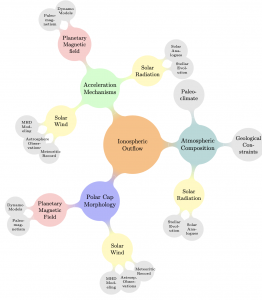A long standing question in studying planetary atmospheres and their connection to their host star is what are the processes that control atmospheric retention or  loss, and how these are controlled by the radiation and stellar wind from the host star, geological processes, and planetary magnetism.
loss, and how these are controlled by the radiation and stellar wind from the host star, geological processes, and planetary magnetism.
The “Heavy Elements” ISSI team will operate throughout 2021-2022 and will address the problem of atmospheric loss of heavy elements on current and geological scales, involving processes starting from surface-air interactions, atmospheric chemistry, circulation patterns, ionization by solar radiation, and ionosphere-magnetosphere and solar wind interactions. Our multi-disciplinary team includes experts from space sciences and planetary sciences, paleomagnetism, and Earth and atmospheric sciences, in order to tackle this problem from all angles presently afforded by the scientific community.
Team discussions would be geared toward creating a broad common scientific basis by allowing team members to share evidence, insight, and open questions in their respective fields and removing barriers. This would allow tackling the issue of ionospheric outflows as an integral part of the Sun-magnetosphere-ionosphere-atmosphere-lithosphere-core chain, and in partic- ular how it has evolved over time. Team discussions, guided by relevant evidence from all fields, would identify how to combine insights and models related to each part of the chain, and would include: (i) Review of known constraints on the Earth’s atmospheric composition in di↵erent geo- logical times (e.g., geology, astrobiology, paleoclimate); Emphasis would be given to understanding how those constraints were derived and whether there are major uncertainties; (ii) Review possible driving mechanisms of atmospheric composition changes (ionic and neutral); Define what would drive those mechanisms, and how well these are known over geological times (e.g. outflows, solar radiation and solar wind, solar and geomagnetic field changes); (iii) Review relevant open questions in each of the sub-fields as they pertain to factors impacting atmospheric composition (see Fig. 2); Define what challenges exist for filling those gaps; (iv) Trace out a path for improving ionospheric outflow modeling in the context of the long-term evolution of the atmosphere; (v) Examine whether this mechanism played a significant role in the past, or how it would act in the future, as outflow simulations are modified and coupled to the best-estimated solar, dynamo, and neutral atmospheric conditions.

